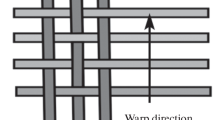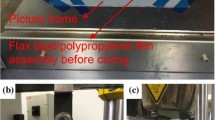Abstract
A statistical analysis of the yarn parameters of a plain woven carbon fiber reinforced polymer composite was conducted using X-ray micro-computed tomography data. An algorithm based on the correlated Gaussian random sequence was proposed to construct statistically equivalent yarns, which were introduced into a numerical multiscale model. A representative volume element was created to evaluate the macroscopic elastic properties of the composite. The predicted elastic constants showed a good agreement with experimental data obtained from tensile, compressive, and shear tests. This showed the importance of considering internal geometric variability for obtaining accurate simulation results. Finally, the performance of an electric vehicle back door made of the composite material was calculated by finite element analysis. The weight of the back door system was reduced by 47.45%, and performance results showed an excellent prospect of using lightweight composites.









Similar content being viewed by others
Abbreviations
- Micro-CT:
-
Micro-computed tomography
- CGRS:
-
Correlated Gaussian random sequence
- RVE:
-
Representative volume element
- CFRP:
-
Carbon fiber reinforced polymer
- VIP:
-
Vacuum infusion process
- A :
-
Area
- AR:
-
Aspect ratio
- PBC:
-
Periodic boundary conditions
- SMC:
-
Sheet molding compound
- UMAT:
-
User-defined material
- CAD:
-
Computer aided design
- CAE:
-
Computer aided engineering
References
Lee, J.M., Lee, K.H., Kim, B.M., et al.: Design of roof panel with required bending stiffness using CFRP laminates. Int. J. Precis. Eng. Manuf. 17(4), 479–485 (2016)
Sequeira, G.J., Lugner, R., Steinhauser, D., et al.: Investigation of intelligent features for CFRP structure in automotive safety systems. In: 2017 2nd IEEE International Conference on Intelligent Transportation Engineering (ICITE), Singapore, pp. 18–24 (2017)
Fuchs, E., Field, F., Roth, R., et al.: Strategic materials selection in the automobile body: economic opportunities for polymer composite design. Compos. Sci. Technol. 68(9), 1989–2002 (2008)
Liu, Q., Lin, Y., Zong, Z., et al.: Lightweight design of carbon twill weave fabric composite body structure for electric vehicle. Compos. Struct. 97, 231–238 (2013)
Obert, E., Daghia, F., Ladevèze, P., et al.: Micro and meso modeling of woven composites: transverse cracking kinetics and homogenization. Compos. Struct. 117, 212–221 (2014)
Gao, J., Liang, B., Zhang, W., et al.: Multiscale modeling of carbon fiber reinforced polymer (CFRP) for integrated computational materials engineering process. In: Purdue University, Proceedings of the American Society for Composites—Thirty-second Technical Conference, Indiana, USA (2017)
Mesogitis, T.S., Skordos, A.A., Long, A.C.: Uncertainty in the manufacturing of fibrous thermosetting composites: a review. Compos. Part A Appl. Sci. Manuf. 57, 67–75 (2014)
Komeili, M., Milani, A.S.: The effect of meso-level uncertainties on the mechanical response of woven fabric composites under axial loading. Comput. Struct. 90, 163–171 (2012)
Zhou, X.Y., Gosling, P.D.: Influence of stochastic variations in manufacturing defects on the mechanical performance of textile composites. Compos. Struct. 194, 226–239 (2018)
Lee, S.-K., Byun, J.-H., Hong, S.H.: Effect of fiber geometry on the elastic constants of the plain woven fabric reinforced aluminum matrix composites. Mater. Sci. Eng. A 347(1), 346–358 (2003)
Endruweit, A., Long, A.C., Robitaille, F., et al.: Influence of stochastic fibre angle variations on the permeability of bi-directional textile fabrics. Compos. Part A Appl. Sci. Manuf. 37(1), 122–132 (2006)
De Carvalho, N.V., Pinho, S.T., Robinson, P.: An experimental study of failure initiation and propagation in 2D woven composites under compression. Compos. Sci. Technol. 71(10), 1316–1325 (2011)
Goldsmith, M.B., Sankar, B.V., Haftka, R.T., et al.: Effects of microstructural variability on thermo-mechanical properties of a woven ceramic matrix composite. J. Compos. Mater. 49(3), 335–350 (2015)
Olave, M., Vanaerschot, A., Lomov, S.V., et al.: Internal geometry variability of two woven composites and related variability of the stiffness. Polym. Compos. 33(8), 1335–1350 (2012)
Desplentere, F., Lomov, S.V., Woerdeman, D.L., et al.: Micro-CT characterization of variability in 3D textile architecture. Compos. Sci. Technol. 65(13), 1920–1930 (2005)
Barbero, E.J., Trovillion, J., Mayugo, J.A., et al.: Finite element modeling of plain weave fabrics from photomicrograph measurements. Compos. Struct. 73(1), 41–52 (2006)
Bale, H., Blacklock, M., Begley, M.R., et al.: Characterizing three-dimensional textile ceramic composites using synchrotron X-ray micro-computed-tomography. J. Am. Ceram. Soc. 95(1), 392–402 (2012)
Vanaerschot, A., Cox, B.N., Lomov, S.V., et al.: Stochastic framework for quantifying the geometrical variability of laminated textile composites using micro-computed tomography. Compos. Part A Appl. Sci. Manuf. 44, 122–131 (2013)
Blacklock, M., Bale, H., Begley, M., et al.: Generating virtual textile composite specimens using statistical data from micro-computed tomography: 1D tow representations for the Binary model. J. Mech. Phys. Solids 60(3), 451–470 (2012)
Rinaldi, R.G., Blacklock, M., Bale, H., et al.: Generating virtual textile composite specimens using statistical data from micro-computed tomography: 3D tow representations. J. Mech. Phys. Solids 60(8), 1561–1581 (2012)
Stock, S.R.: Recent advances in X-ray microtomography applied to materials. Int. Mater. Rev. 53(3), 129–181 (2013)
Xia, Z., Zhang, Y., Ellyin, F.: A unified periodical boundary conditions for representative volume elements of composites and applications. Int. J. Solids Struct. 40(8), 1907–1921 (2003)
Acknowledgements
This work was supported by the National Natural Science Foundation of China (Grant Nos. 11372181, 11772191, 51705312) and the China Postdoctoral Science Foundation (Grant No. 2017M61156). The authors acknowledge the support provided by Shanghai Jiao Tong University to Prof. Wei Chen.
Author information
Authors and Affiliations
Corresponding author
Rights and permissions
About this article
Cite this article
Zhu, C., Zhu, P., Liu, Z. et al. Prediction of the Elastic Properties of a Plain Woven Carbon Fiber Reinforced Composite with Internal Geometric Variability. Automot. Innov. 1, 147–157 (2018). https://doi.org/10.1007/s42154-018-0015-y
Received:
Accepted:
Published:
Issue Date:
DOI: https://doi.org/10.1007/s42154-018-0015-y




